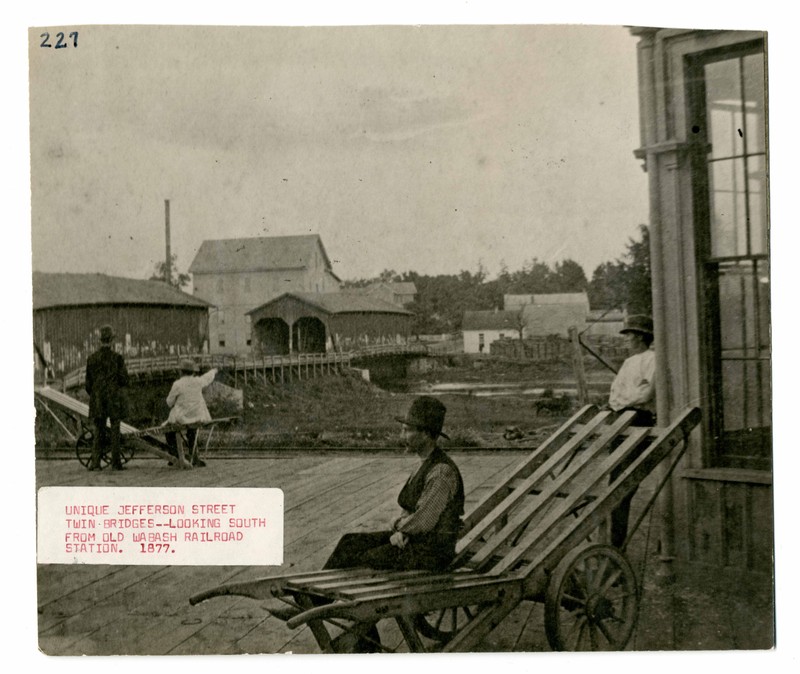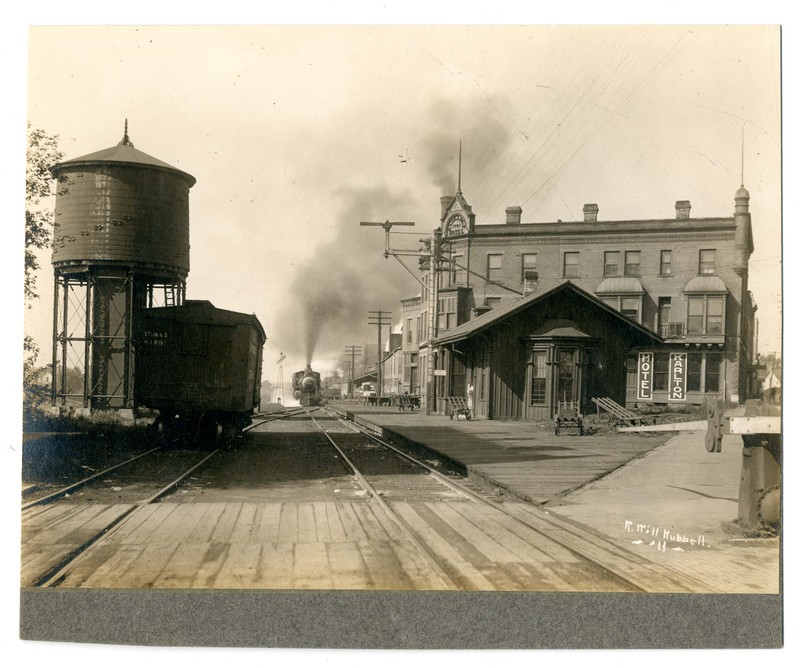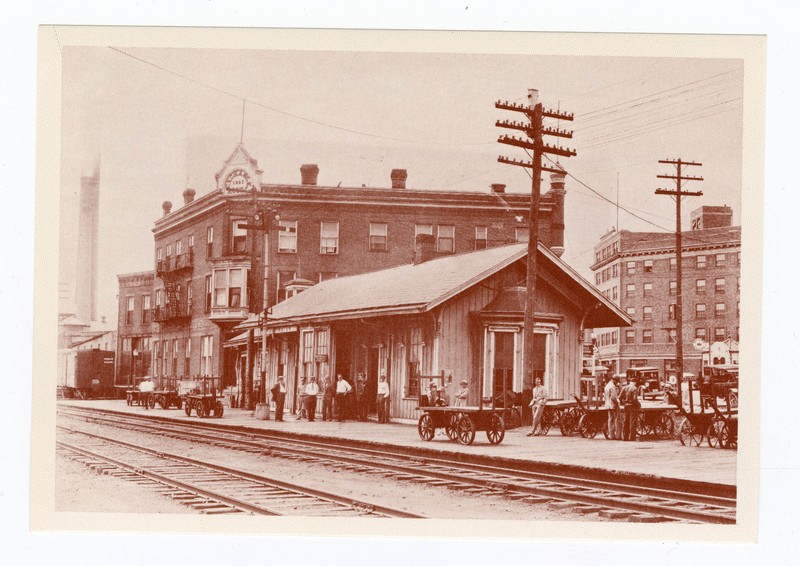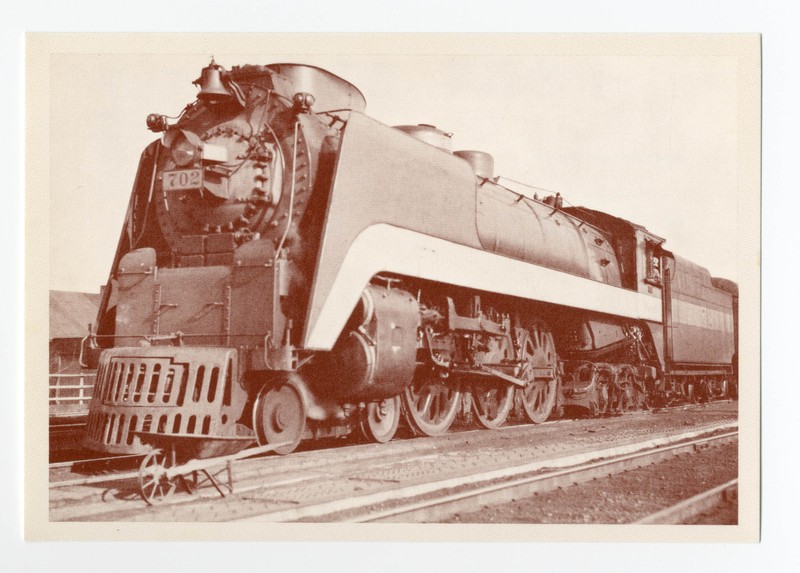Schenkel's Station
Introduction
Text-to-speech Audio
Built in 1928, the former Wabash Railroad Passenger Station was completed using brick and stone. In 1855, the first train arrived in Huntington from Fort Wayne along the newly built Erie, Wabash & St. Louis Railroad. Much later, the station saw the passing of the famous Wabash Cannonball. The Cannonball was named after the song of the same name which was originally written in the 1880s and re-popularized in 1929 by the Carter Family (including Johnny Cash's future mother-in-law) and 1932 by Roy Acuff. The Cannonball operated on this line from 1950 until 1971.
A separate baggage station for freight and other large baggage was built at the opposite end of the courthouse. Most recently it functioned as Pizza Junction.
Images
View from Wabash RR Train Station Platform (1877)

Trackside View of Wabash RR Station (about 1950)
.jpg)
Wabash Depot and Water Tank (1911)

Wabash RR with Station (about 1930)

Current Schenkel's Station
.jpg)
Wabash Cannonball (about 1950)

Wabash RR Station (about 1960)
.jpg)
Backstory and Context
Text-to-speech Audio
The first depot was a wooden shack. This was then replaced with a wooden building. The current building was designed to include the railroad offices, a waiting room, men’s and woman’s restroom, a heating plant and baggage room. The contact was awarded to Walsh Construction Company of Chicago and the estimated cost was $60,000.
The building has served many functions; a passenger station for the Wabash Railroad, a station for the Norfolk & Western Railroad, by 1979 it sat vacant, in 1989 the Express Printing business was housed here. In 2013, John and Shelly Shenkel donated the station to the city of Huntington to be used as a hub for the trails and greenway. The station has been renamed Schenkel’s Station.
The Huntington County Interim Report, 2nd Edition, labels the architecture style as Craftsman/Art Deco. Art Deco was popular from 1925 to 1940 in Indiana. The Art Deco features of this building are the simple building design with flat roof, geometrical details, stylized floral motifs and the herringbone brick panels. The Wabash Railroad Depot is location number 81 on the National Register of Historic Places registration form for the Huntington Courthouse Square Historic District which was approved in 1992.
Sources
- “The Proposed Wabash Railroad Station,” The Huntington Press [Huntington, IN], 13 July 1928.
- “Art Deco & Art Moderne Style,”, IN.gov, accessed July 12, 2021, https://www.in.gov/dnr/historic-preservation/learn-about-topics/buildings-and-bridges/architectural-styles/art-deco-and-art-moderne-styles/
- Huntington County Interim Report 2nd Edition, Indiana 1982. This book can be located at the Huntington City-Township Public Library. hctpl.info.
- “Contracts are Awarded for New Wabash Station,” Huntington Press [Huntington, IN], 26 June 1928.
- National Register Digital Places. National Registry of Historic Places. Accessed July 22, 2021. https://npgallery.nps.gov/NRHP/GetAsset/85461645-f775-4cf8-a822-d8525b7cf0ba
- "Wabash Cannon Ball (train)." Wikipedia. Accessed 17 Jan 2023. https://en.wikipedia.org/wiki/Wabash_Cannon_Ball_(train)
- "Carter Family." Wikipedia. Accessed 17 Jan 2023. https://en.wikipedia.org/wiki/Carter_Family
Collection of the Huntington City-Township Public Library, hctpl.info
Collection of the Huntington City-Township Public Library, hctpl.info
Collection of the Huntington City-Township Public Library, hctpl.info
Collection of the Huntington City-Township Public Library, hctpl.info
Staff Photo
Collection of the Huntington City-Township Public Library, hctpl.info
Collection of the Huntington City-Township Public Library, hctpl.info
